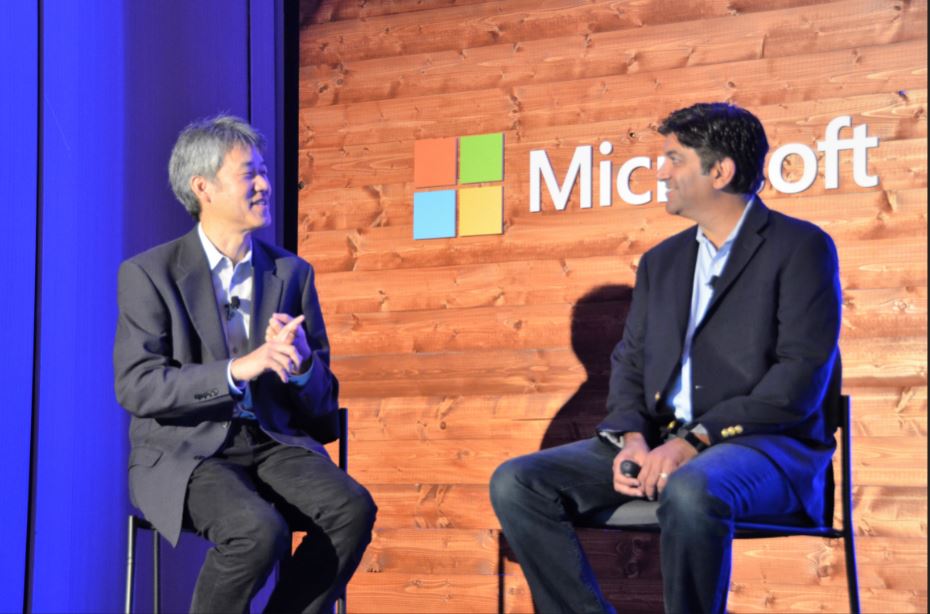
The digital healthcare revolution needs you

 This blog post was co-written by Peter Lee, Corporate Vice President for Microsoft Healthcare; and Aneesh Chopra, President of CareJourney (pictured left).
This blog post was co-written by Peter Lee, Corporate Vice President for Microsoft Healthcare; and Aneesh Chopra, President of CareJourney (pictured left).
At Microsoft Envision 2018, we had fun speaking about our shared interest in healthcare—we’re both passionate advocates of using data to transform how healthcare is delivered. But this was far from the first time we’ve discussed our respective visions for how technology can reshape society.
During our respective tenures as an Office Director at DARPA and CTO of the United States during the Obama Administration, we each learned how critically important data, technical innovation, and seamless but controlled access to information is to ensuring military readiness, protecting public safety, and delivering effective healthcare.
We’ve seen the demand for innovative, intuitive, consumerized digital experiences in all aspects of our lives—and the unparalleled problem-solving potential they promise. And we’ve learned that there’s always a complex interplay between new technologies, public policies, and business models that all need to come together in the right way for positive change to take place.
Ultimately, making this happen is a team sport, so we need to think about how best to equip the players. And when it comes to transforming healthcare, the most important piece of equipment is a standardized data foundation or common architecture. What’s exciting both of us now is that this standardized data foundation is becoming real after years of productive collaboration, and so now is the time for everyone—all of us—to work together to make the best use of it.
A standardized data foundation
Integration is the foundation for so much of the technology that dominates our personal and professional lives today. When services are built on a shared platform, or use a common data language, there are huge opportunities for interoperability across organizations and systems—usually adding up to deeper, faster, and more satisfying experiences for everyone.
In healthcare, the promise is particularly strong. A common data language and architecture would make healthcare services easier and simpler to engage with, improve the speed and predictability of care, and support the delivery of precision medicine that ultimately saves more lives.
Overwhelmingly in the consumer space, this kind of interoperability is powered by APIs. But in healthcare, where operations are hugely fragmented between insurers, payers, institutions, and providers, the journey toward a common data language for API-based integration has been difficult—and slow.
Now, however, that’s starting to change.
In March, the United States outlined a new government commitment to ensuring health data interoperability—and open access to data for patients. In August, Microsoft, Amazon, Google, IBM, Oracle, and Salesforce announced their joint commitment to open standards for health data, and to developing tools based on the Fast Healthcare Interoperability Resources (FHIR) standard.
These big steps forward build on years of policy and technology advances, from the Obama administration’s funding for R&D into API standards back in 2010, to finalized EHR consumer-access regulations in 2015, open-API mandates in the 21st Century Cures Act, and Apple Health adopting FHIR specs earlier this year.
Based on data just published by the Office of the National Coordinator for Health Information Technology, over 80 percent of hospitals and over 60 percent of Merit-based Incentive Payment System-eligible clinicians have EHRs from vendors that are FHIR ready.
With both the US government and many of the biggest names in technology onboard, the stage is set for major transformation—but there’s a long way to go.
Open standards and data sharing in healthcare
August’s interoperability announcement is a major milestone in the move to broad standardization of the data critical for healthcare. It will be a huge boon, not only for patients and their healthcare providers, but also for every organization that creates, stores, and analyzes health data.
Of course, we can’t simply standardize everything right away—we have to be pragmatic. We can start by promoting more open APIs and building variable data into a consistent payload. The variety of medical data—from high-resolution imaging and unstructured notes, to pathology data and genomics—grows deeper every day, across more organizations than ever.
As key organizations work together to supply a common API, many others are now committing to ensuring their data and technologies speak the same language. Microsoft is committed to supporting this standardized approach, both directly through FHIR supported solutions such as Microsoft Dynamics 365 Healthcare Accelerator that make health compliance easier, and by helping other organizations standardize their data foundation.
Microsoft is also joining the CARIN Alliance, which is dedicated to accelerating the adoption of consumer-directed data exchange across healthcare in the United States.
For this journey to end in success, we need as many companies on board as possible, joining the community of individuals and organizations working together to resolve the interoperability issue. Whether you’re a developer, a policy-maker, or just want to be an early adopter of what’s set to become the new standard for healthcare data, we all have a role to play in bringing this vision for a common data language to life.
Get involved
Get involved in the conversation. Help us discover how we can establish a smarter, more open future for healthcare.




